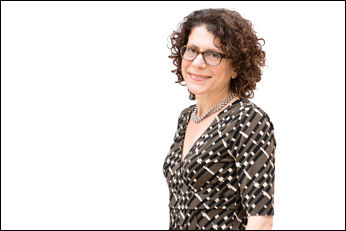When the American photographer Berenice Abbott (1898–1991) returned to the United States in January 1929 after eight years in Europe, she was seized by a “fantastic passion” to photograph New York. Abbott wandered the city with a small handheld camera, photographing bridges, billboards, newly erected skyscrapers, elevated trains, and neighborhood street life. She then pasted these “notes,” as she called them, into a standard black-page album, arranging them by subject and general locale. Consisting of 266 photographs across thirty-two pages, Abbott’s New York album offers an intimate view of the city at a moment of great cultural and urban transformation.
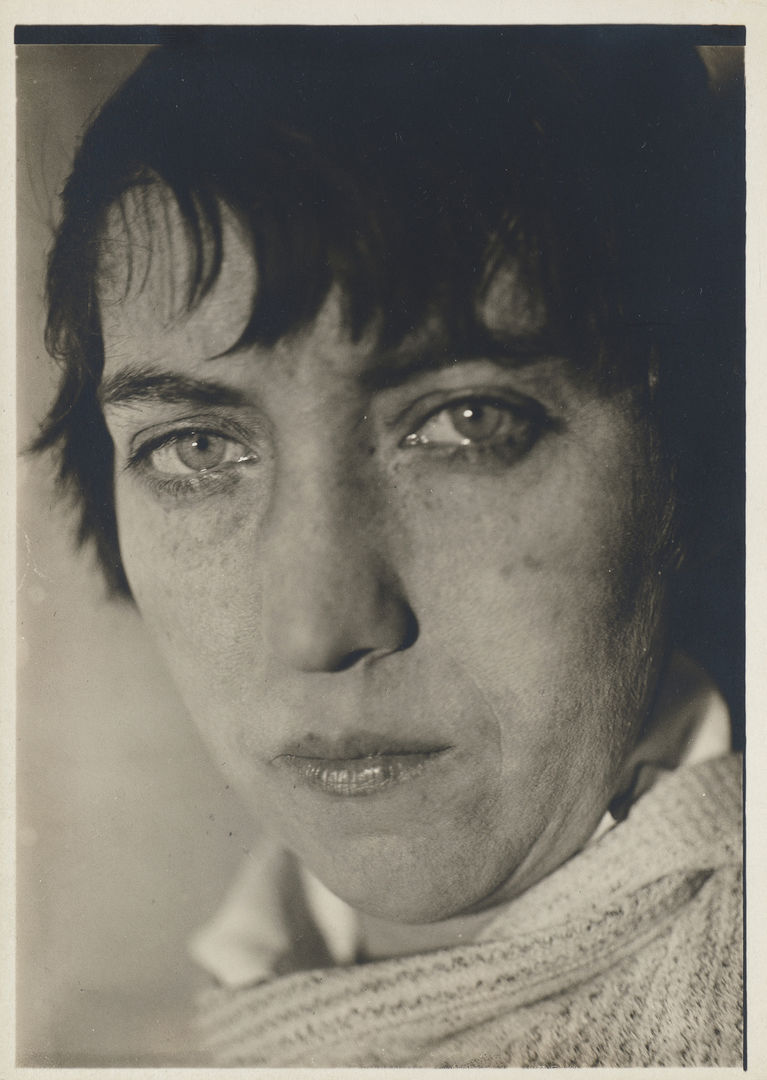
Walker Evans, (American, 1903–75). Berenice Abbott, 1929–30. Gelatin silver print, 6 5/8 x 4 5/8 in. (16.9 x 11.8 cm). The Metropolitan Museum of Art, New York, Purchase, The Horace W. Goldsmith Foundation Gift, through Joyce and Robert Menschel, 1997 (1997.10)
In preparation for the exhibition, Berenice Abbott’s New York Album, 1929, which highlights this undervalued treasure from our collection, I set out to identify the various locations depicted in the photographs. As the album bears almost no notations, this had to be done through visual recognition of streets, buildings, and other urban landmarks. While I’m a native New Yorker and have lived in the city most of my life, the urban landscape has changed quite a bit since 1929 and architectural history is not my expertise. On the recommendation of a colleague at the Museum of the City of New York, I reached out to Celedonia “Cal” Jones, the Manhattan Borough Historian Emeritus, who has an avid interest in the history of the city and its diverse communities, and he kindly agreed to take on the task. Now retired, Cal works with his daughter, Diane Jones Randall, and son, Kenneth Jones, as the Jones Family Research Collective, collaborating with families and cultural institutions on research projects related to genealogy and New York City history.
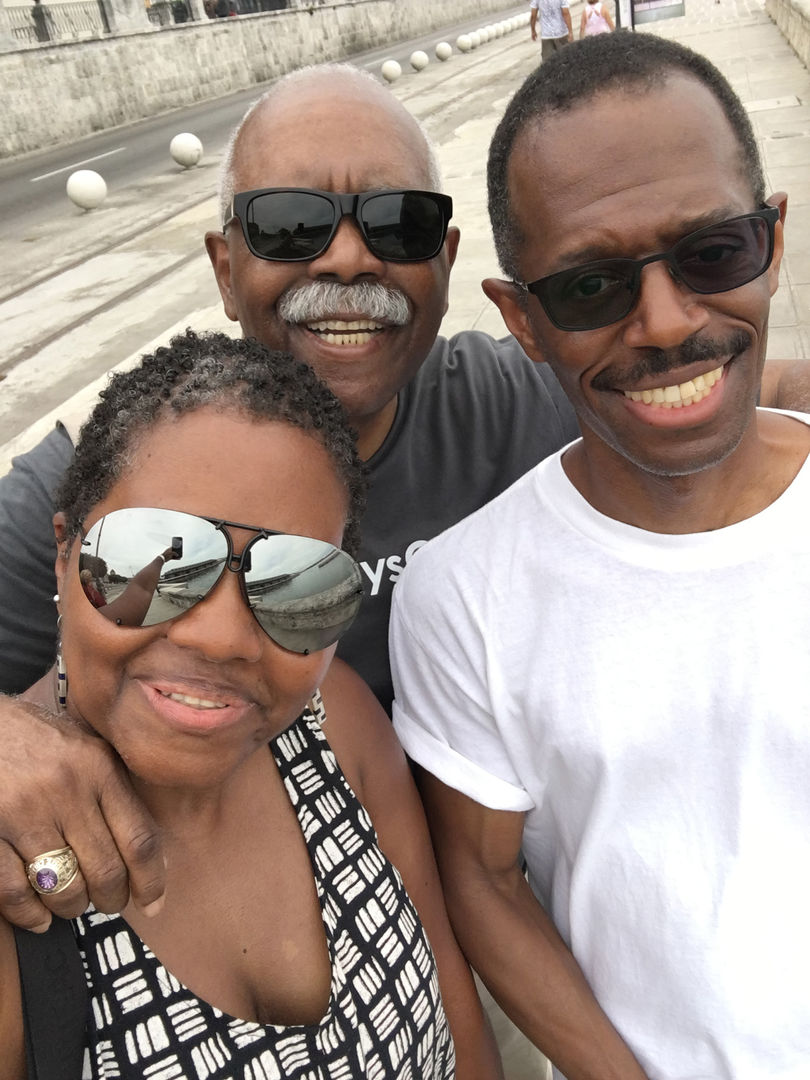
Celedonia “Cal” Jones and his children, Diane Jones Randall and Kenneth Jones. Photo courtesy Cal Jones
For several months, the Jones family pored over digital scans of the album pages, enlarging images on their screens to discern tiny details, such as building numbers and signs in shop windows. They consulted old maps of the city and architectural history books. Cal, a charming, vibrant man in his early nineties, made several trips downtown to verify his identifications of buildings, craning his neck to count windows on the facades of skyscrapers. But perhaps the most valuable resource at the Joneses’ disposal was memory—their shared mental database of visual recollections acquired through several generations of New York City living.
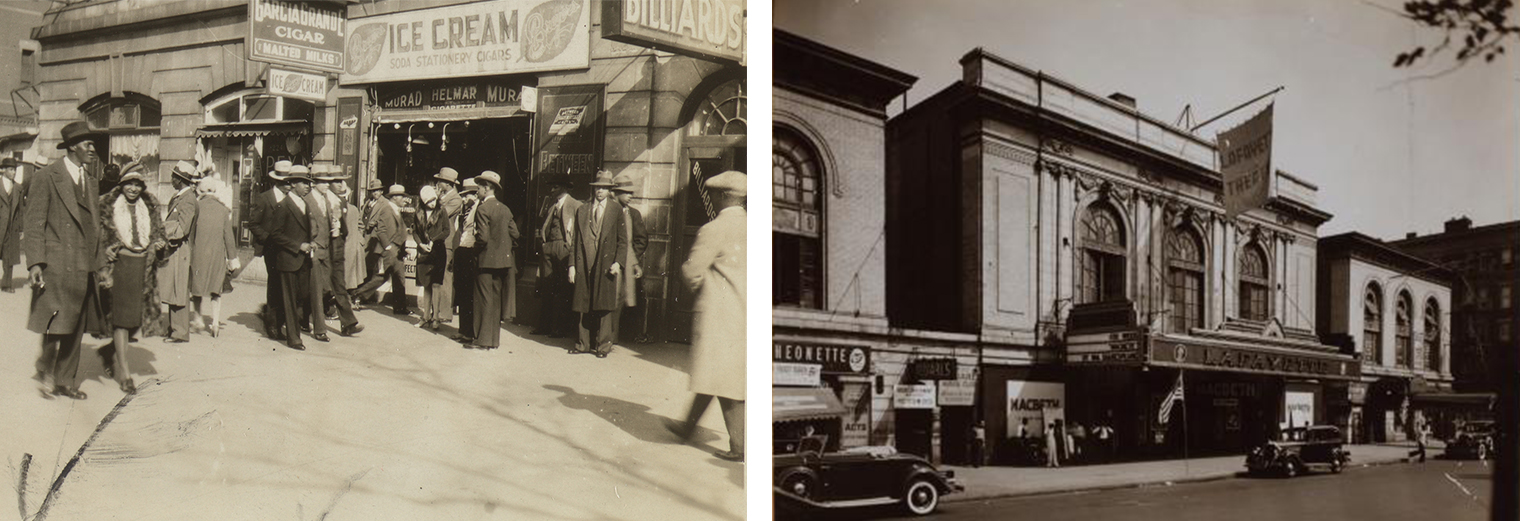
Left: Berenice Abbott (American, 1898–1991). Ice cream parlor next to the Lafayette Theater on Seventh Avenue (Adam Clayton Powell Jr. Boulevard) between 131st Street and 132nd Street, 1929. From Album Page: Central Harlem, 135th Street Vicinity, Manhattan, 1929. Gelatin silver print, 2 1/8 x 3 1/8 in. (5.4 x 7.9 cm). The Metropolitan Museum of Art, New York, Gift of Emanuel Gerard, 1982 (1982.1180.78–.86). Right: Manhattan: 7th Avenue—131st Street, 1936. Courtesy New York Public Library
In some cases, the images in Abbott’s album intersected with the Joneses’ family history and sometimes with my own. Looking at a photograph of a crowd of well-dressed people gathered in front of an ice cream parlor, Cal recognized the stone facade of Harlem’s historic Lafayette Theater on Seventh Avenue (now Adam Clayton Powell Jr. Boulevard) and 132nd Street. Known as the “House Beautiful,” it was the first major New York theater to desegregate its orchestra seating. In addition to plays, the Lafayette regularly hosted jazz performances featuring Duke Ellington, Chick Webb, and Fletcher Henderson, some of which Abbott, a jazz fan herself, may have attended.
Just next door to the theater was a nightclub called Connie’s Inn, which had a ballroom that was used for training African American men in the 15th Infantry Regiment of the National Guard for military service in World War I. Cal’s grandfather, Celedonia Phillips, lived nearby on 131st Street and served as a company clerk and corporal in the regiment. The government did not provide the soldiers with real weapons, so they trained with toy guns and makeshift rifles. They went on to fight heroically alongside French troops on the battlefields of Europe, and came to be known as the Harlem Hellfighters.
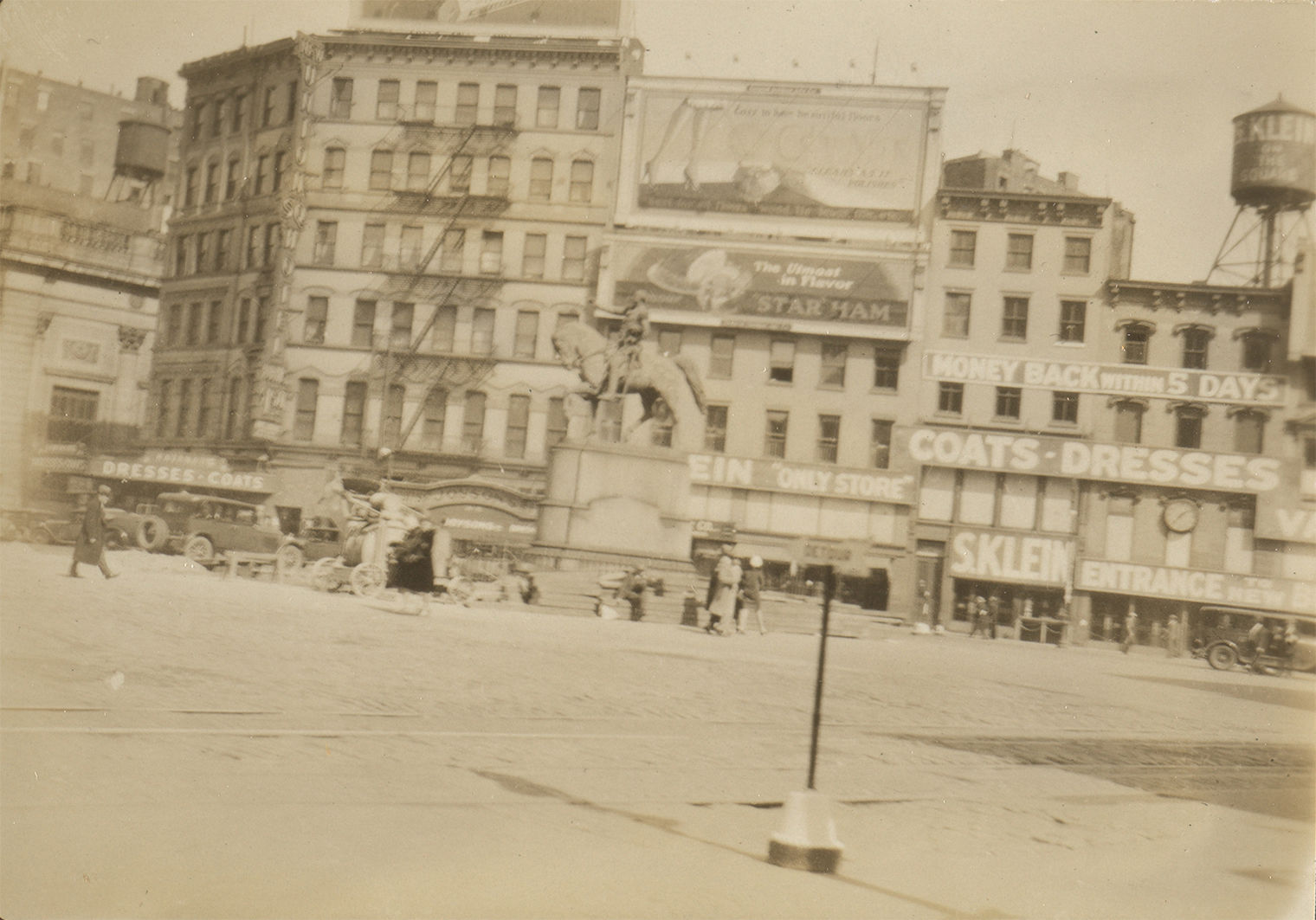
Berenice Abbott (American, 1898–1991). S. Klein on Union Square, 1929. From Album Page 10: Lower East Side, The Bowery Vicinity, Manhattan, 1929. Gelatin silver prints, 10 x 13 in. (25.4 x 33 cm). The Metropolitan Museum of Art, New York, Gift of Emanuel Gerard, 1981 (1981.1246.10–.18)
Another photograph from the album shows a collection of massive block-lettered signs plastered across a row of buildings on Union Square East: COATS, DRESSES and MONEY BACK WITHIN 5 DAYS. The buildings belonged to S. Klein, one of New York’s first discount department stores. I recall my maternal grandmother telling me she worked at S. Klein as a teenager—right around the time Abbott made the photograph. According to my mother, though, my grandmother never worked at S. Klein but loved to shop for clothes at the chaotic bargain tables in the basement. Either way, S. Klein managed to stay in business for sixty-five years before it finally closed its doors in 1975.
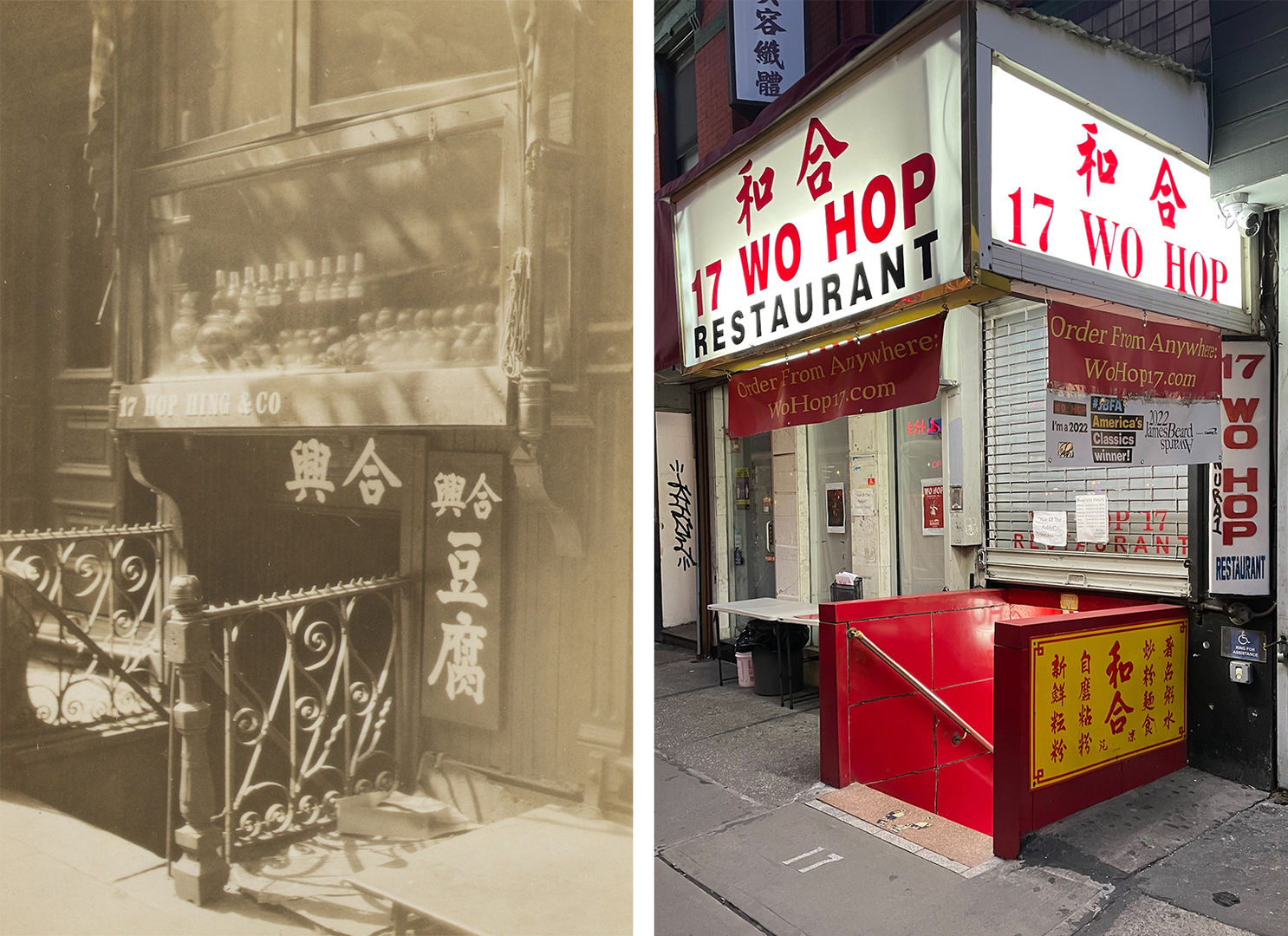
Left: Berenice Abbott (American, 1898–1991). 17 Mott Street, 1929. From Album Page: Chinatown, Mott Street Vicinity, Manhattan, 1929. Gelatin silver prints, 10 x 13 in. (25.4 x 33 cm). The Metropolitan Museum of Art, New York, Gift of Emanuel Gerard, 1979 (1979.678.1–.8). Right: Image of 17 Mott Street taken in 2023. Photo courtesy Peter Barr
Abbott also made several photographic excursions to Manhattan’s Chinatown. On one occasion, she photographed the fancy wrought-iron railings in front of 17 Mott Street, which at the time belonged to a Chinese grocery store called Hop Hing & Co. Today, that space is home to Wo Hop, one of Chinatown’s oldest restaurants, which has been serving food continuously since 1938. A bright red-and-yellow entryway replaced the original iron railings, but you still can climb down the same steep granite steps and experience firsthand the mingling of past and present.
Through our research, we successfully identified the neighborhoods depicted on every album page and pinpointed the exact locations of dozens of individual images. Some places Abbott photographed, such as the main branch of the New York Public Library and Trinity Church on Wall Street, haven’t changed much since 1929. Others, such as the Lafayette Theater and Manhattan’s four elevated train lines, have vanished completely. Several sites have gone through multiple transformations over the past century. The National Winter Garden Theater on Houston Street and Second Avenue opened in 1912 as a cinema and vaudeville theater. By the time Abbott photographed it, it had been converted to a burlesque house; today, it’s a Whole Foods. Discovering the locations depicted on these album pages has deepened our understanding of Abbott’s vision of New York as a vibrant metropolis that is, and always has been, defined by change.
Explore a digital map of select locations Abbott photographed across Manhattan

